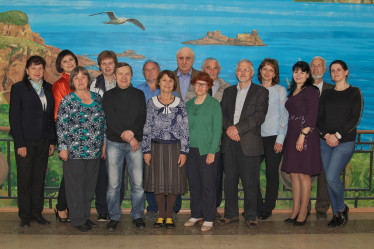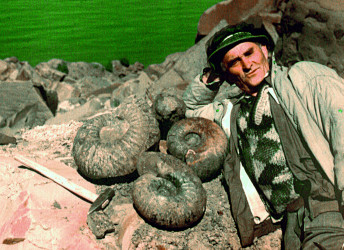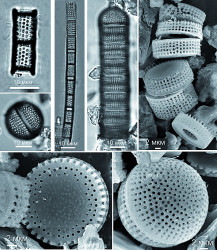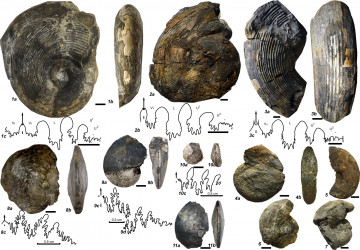Laboratory of Stratigraphy and Paleontology
Head of the Laboratory, Prof. Igor V. KEMKIN
Tel. +7-(423)-2317-801
E-mail: This email address is being protected from spambots. You need JavaScript enabled to view it.
 |
The Laboratory of Stratigraphy and Paleontology was created in March 1961 by an expert in micropaleontology Dr. Sc M.N. Gramm on the basis of the palynology room that was part of the Laboratory of Sedimentary Formations of FEGI. The primary objects of study were the Cenozoic flora, spores and pollen. In the years to follow the laboratory was staffed with scientists specializing in different groups of flora and fauna. The laboratory’s backbone was formed towards the end of 1960-s by such specialists as V.A. Krasilov, Yu.D. Zakharov, V.I. Medyulyanov, Yu.G. Zhuravlev, V.V. Fedotov, A.G. Ablaev, who investigated problems of paleontology, biostratigraphy and evolution, thus contributing to the development of regional stratigraphic schemes and legends for geological maps of different scale. In 1972 the major part of the laboratory’s personnel headed by M.N. Gramm moved to the Institute of Biology and Soil Sciences. However, in 1975 the laboratory was restored in FEGI under the direction of Doctor of Geological and Mineralogical Sciences A.G. Ablaev, comprising renowned specialists, Doctors of Sciences B.V. Poyarkov, Z.M. Poyarkova and V.S. Markevich as well as young scientists. In 1981 Doctor of Geological and Mineralogical Sciences E.V. Krasnov took charge of the laboratory, expanded the biostratighraphic research and recruited new specialists such as Candidates of Sciences G.V. Belyaeva, G.I. Burii, A.M. Popova and a number of young scientists, who all made a significant contribution to the dating and differentiation of carbonate-siliceous-terrigenous deposits of Sikhote-Alin, Sakhalin and Kamchatka. Since 1988, under the guidance of Doctor of Geological and Mineralogical Sciences Yu.D. Zakharov, beside the traditional paleontological, biostratigraphic and evolutionary fields of study, the laboratory started conducting isotopic research of the organic remains in order to reconstruct
the paleoclimatic and paleogeographical conditions of the ancient organisms’ habitat. From 2005 up to now the laboratory is headed by Doctor of Geological and Mineralogical Sciences I.V. Kemkin specializing in sedimentary complexes of ancient accretionary prisms of the Sikhote-Alin fold region and radiolarian analysis. Thus, the laboratory’s activity was broadened with the regional-geological aspect. In 2017 due to the restructuring of FEGI FEB RAS units the Laboratory of Stratigraphy was merged with the Laboratory of Cenozoic Stratigraphy headed by Doctor of Geological and Mineralogical Sciences V.S. Pushkar who specializes in diatomic climatostratigraphy. This group’s main field of study is the Cenozoic evolution of paleoecosystems in Eastern Asia and Northern Pacific, and its connection to the tectogenesis and global climatic events.
 |
As of today the Laboratory of Stratigraphy and Paleontology employs 16 workers, comprising 3 Doctors and 8 Candidates of Sciences, who conduct research in the following fields:
- Paleontology and evolution of organisms,
- Biostratigraphy,
- Isotopic and geochemical research,
- Paleoclimatic and paleogeographical research,
- Regional geology.
 |
The most important latest results are:
- Based on the material from northeastern Asia, a significant variation in values of 87Sr / 86Sr between the middle Permian minimum (up to 0.70701) and the Early Triassic maximum (up to 0.70904) was observed. This phenomenon probably owes to the two serious events of the Phanerozoic:
(1) the strengthening of the middle Permian volcanogenic (ophiolite) activity caused by the opening of the Neo-Tethys Ocean and followed by input of low radiogenic Sr into the seawater, and (2) Early Triassic intensification of the weathering processes in hot climate; - Reconstruction of the Northeastern Asia marine environment of middle and high paleolatitudes was made based on the N and С isotope data obtained for the first time for the Permian-Triassic clay rocks of Verkhoyanye, Kolymo-Omolonsk district and southern Primorye;
- For the first time the temperature conditions of habitation of different groups of invertebrates found in the Lower Cretaceous rocks of 16 districts in North Caucasus and Georgia were determined based on the isotopic and oxygenic composition of their skeletons;
- New and rare taxons of macro- and microfauna as well as of microflora that reflect the important events in the organic world and environment evolution were studied and described. In particular, we are speaking of the brachiopod fauna recovery after the mass extinction in the end of the Permian period, the beginning of the global cooling in the middle-upper Miocene in the south of the Far East, determined by diatom dating, etc.;
- It was determined, based on the difference in facies environments of silica accumulation from the periphery of the Pacific Ocean towards its spreading center obtained from geochemical study of cherts from different structural levels of the Samarka terrane, that sedimentary cover of the paleoocean was fragment-by-fragment accreted to the continental margin during the oceanic plate subduction. The Jurassic accretionary prism with its intensely dislocated strata of constituting terranes and a total thickness of about 36 km is a characteristic representative of this scenario. The study allowed the oceanic plate’s drift history to be reconstructed and rates of its progressive movement during the Jurassic to be calculated.
 |
The laboratory scientists’ research results were published in the leading Russian and international journals included in both the Russian (RSCI) and international citation databases (Scopus and Web of science). Beside the scientific activity the laboratory’s workers lecture and guide graduation qualification papers of tudents of the Far Eastern Federal University. It is worth noting that the laboratory’s personnel actively participate in international projects and programs aimed: at btaining data on the boundaries of certain Phanerozoic stratigraphic units and faunal zones on the basis of study and description of taxa of fossil animals and plants; at reconstructing the organisms’ habitat factors of different geochronological intervals on the basis of isotope geochemistry and bioclimate and stratigraphy researches; at reconstructing the depositional environment of different genesis sedimentary strata formation in the Mesozoic-Cenozoic, including the intensely dislocated tectono-sedimentary complexes of the accretionary prisms of the Sikhote-Alin orogenic belt.

